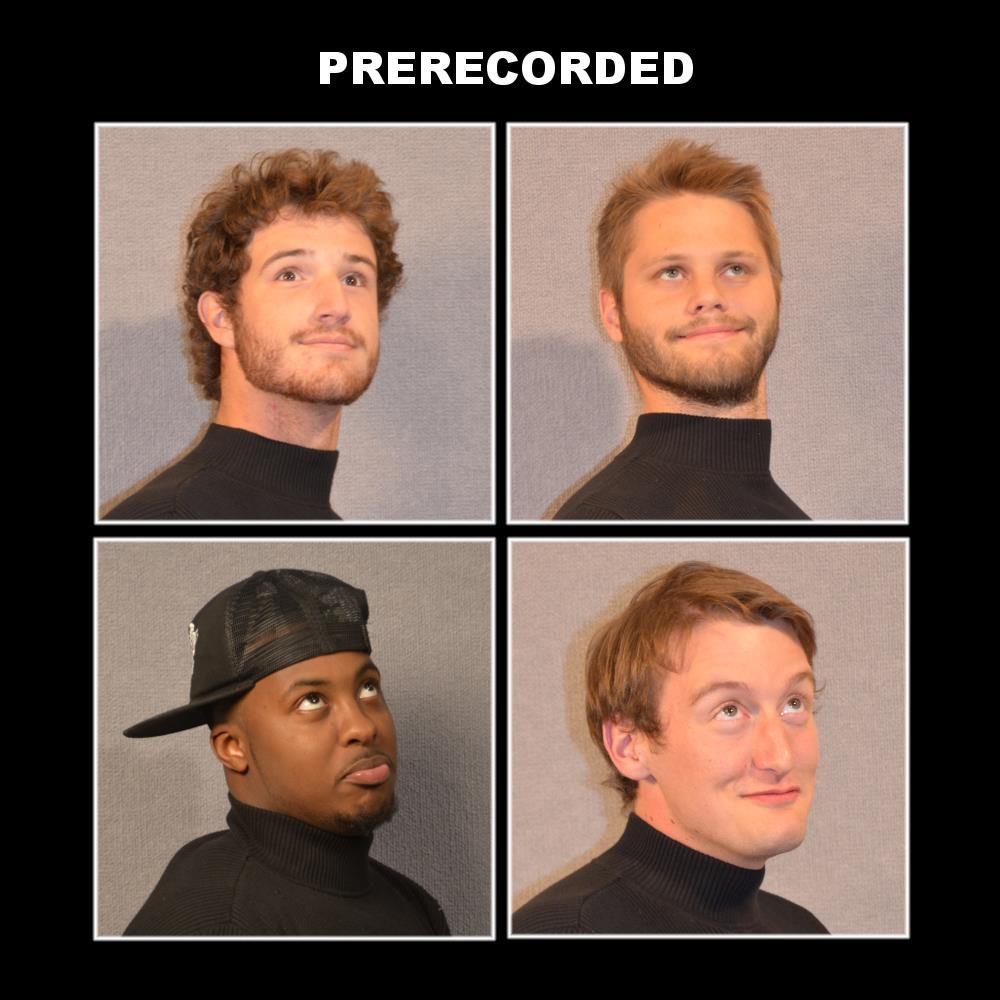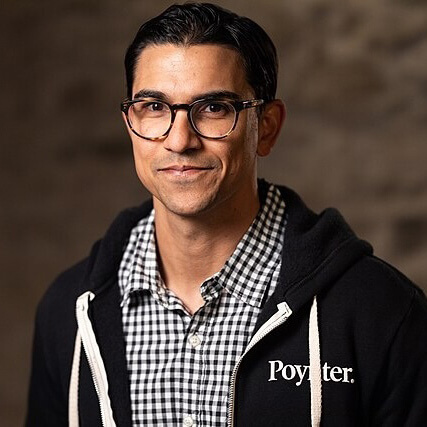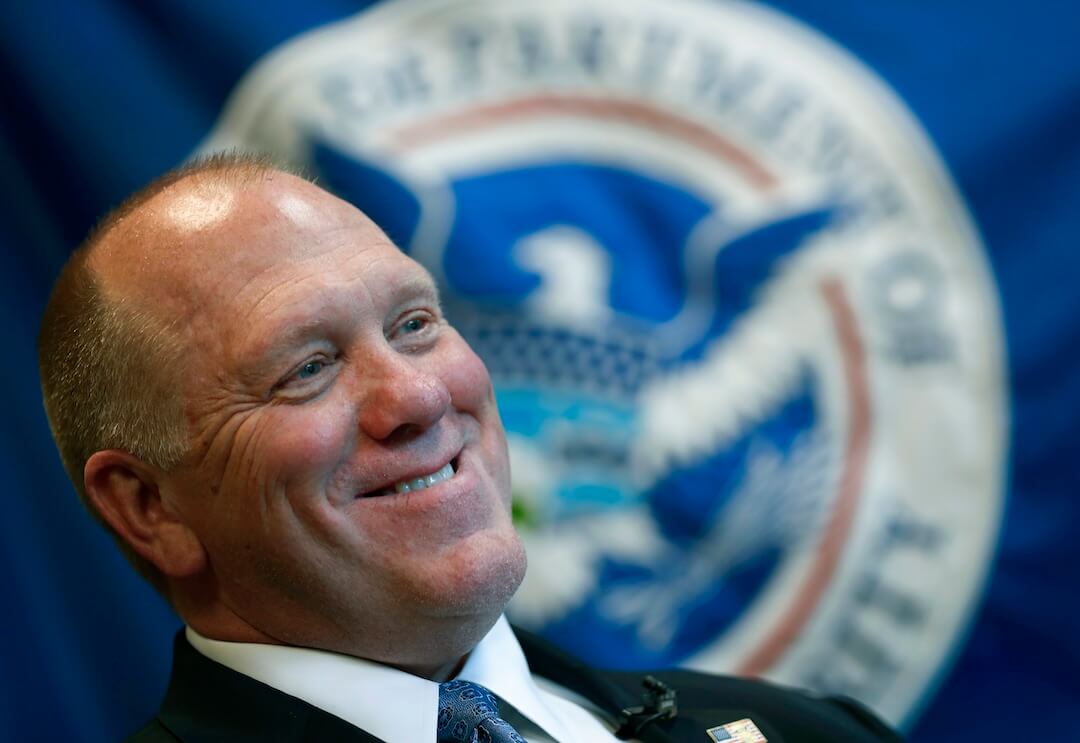On Dave Jorgenson’s first full day in New York City in 2012, his producer on “The Colbert Report” sent him to Chinatown to haggle for five snails to play GOP primary contenders in a sketch.
On another errand, he spent the last $120 of his personal cash on a cowboy hat identical to the one Herman Cain wore in an ad mocked by the show. Jorgenson had no idea when he’d be reimbursed.
“The first thing (Stephen Colbert) did is come out and throw the hat into the audience,” said the 28-year-old Jorgenson, now video producer at the Washington Post. “I was like ‘Noooooo!’”
His Comedy Central late-night experience landed Jorgenson at the intersection of politics and satire with the video department at the Post. There, he’s managed to carve out a niche on the latest platform purported to be journalism’s savior: TikTok.
Spoiler alert: TikTok’s probably not going to save journalism. But 16.2 million people under 25 use the app, and users open it eight times a day for a total of 46 minutes, according to an investment pitch reported by Digiday. Jorgenson is confident that when the video-based service adds the ability to include links in video descriptions, it could be a funnel for new Post subscribers — and for news consumers everywhere.
“I mean, it’s just a crazy, huge, untapped audience of teenagers,” said Jorgenson, who oversees his paper’s TikTok strategy, which as of the end of September has generated more than 146,000 fans and 3.2 million likes across 98 videos.
A humble self-awareness, respect for teenage voices and a penchant for dad jokes — on top of an entrepreneurial spirit — propelled an Eagle Scout from Shawnee, Kansas, to street-shoutout stardom on the newest “it” social media platform.
“I’m going to tell my dad you called me ‘entrepreneurial,’” he said with a laugh in a recent Google Hangout. “I’m more led by the creative side of it; I’m motivated creatively and that ends up being the reason I take on a project.”
Pumpkin spice Spam and the Post’s TikTok strategy
If you’re dialed into journalism Twitter, you’ve probably seen the bizarre videos Jorgenson shares from the Post’s TikTok. If you’re not, then you’ve probably seen other viral videos from the social media site, which is owned by the China-based company ByteDance.
TikTok is largely populated by short videos, usually 15 seconds, featuring a song and weird editing effects, like turning a person into a human tornado. Videos are fed to users through hashtags.
One of the Post’s most recent TikToks, which racked up more than 3 million views, featured Jorgenson eating a gelatinous loaf of pumpkin spice-flavored Spam with his bare hand. He then tapped James Beard Award-winning Post reporter Maura Judkis for a follow-up video in which she decries eating the processed meat product cold. That helped push the account’s views for the week past 5.3 million.
There’s no way to tell if there’s a correlation, but the search term “pumpkin spice spam” reached its highest point in Google since Hormel announced the product in August.
Today’s second @washingtonpost @tiktok_us brought to you by my lunch break, autumn and @hcjewell https://t.co/oN9Vuytl6n pic.twitter.com/Z3nT4eaK0X
— Dave Jorgenspook 🎃 (@davejorgenson) September 24, 2019
The video is an example of the crux of the Post’s TikTok strategy: Highlight the brand and expose teen viewers to a variety of reporters and beats.
“TikTok and its ilk are definitely a mutant strain of memeology that encourage repetition with quick, easy-to-digest narratives,” said Gene Park, who has been audience editor at the Post for four years. “Part of what Dave does is mix trending TikTok memes with slice-of-life newsroom insight, which gives us the ability to laugh at ourselves while also hinting at the depth of our work.”
Jorgenson has featured Pulitzer Prize winners Robin Givhan and Bob Woodward, and admits he still approaches colleagues as if he’s a college student worried about agitating a professor.
Woodward agreed to be in a TikTok, but refused to dance or raise the cookie he was eating.The only reason Jorgenson thinks he participated is because he was in a good mood after meeting with the Post’s summer interns.
Today’s @washingtonpost @tiktok_us features @realBobWoodward https://t.co/MxGxkFb9xg pic.twitter.com/BXdhZP3LXa
— Dave Jorgenspook 🎃 (@davejorgenson) July 22, 2019
So far, there’s no way to track whether TikTok is leading to more subscribers at the Post. And, like when Facebook tweaked its algorithm in 2018 and reduced traffic to publishers, social media platforms ultimately control the distribution of clicks and views.
Jorgenson recently deleted a few tweets that questioned whether the company had throttled traffic to the Post’s TikTok after a story critical of the country’s actions in Hong Kong.
“I am very aware of like, if TikTok ever decided, ‘Oh, we don’t like this web this page or whatever,’ they could turn the faucet off, so to speak,” Jorgenson said. “So I certainly have that paranoia.”
But for now, he’s not seeing that happen, and he’s bullish on a company that he said continues to innovate.
The Eagle Scout behind the Post’s TikTok
Jorgenson grew up with the same creative spark that guides his work at the Post today. He drew cartoons, was obsessed with Legos and completed jigsaw puzzles from the middle out, said 32-year-old Ellen Jorgenson, one of his three older sisters who turned him into “the friendly punching bag.”
“That is just how his brain has always worked,” said Ellen, a high school teacher and basketball coach in Lincoln, Nebraska. “He thinks outside the box.”
an event I’m speaking at asked for a headshot but they didn’t specify the year soooooooooo pic.twitter.com/rsyxV0w77M
— Dave Jorgenspook 🎃 (@davejorgenson) September 16, 2019
Perhaps the most prescient creative pursuit: a music video Jorgenson and his sisters shot for the 1966 Lovin’ Spoonful song “Summer in the City,” in which he strutted down his cul de sac in an oversized coat and sunglasses.
Michelle Jaconi, executive producer at the Post and Jorgenson’s boss, said she suspects his Eagle Scout values were helpful for building a following on a community-based platform like TikTok.
Jorgenson spent a lot of his youth helping younger scouts win their merit badges, teaching him a respect for younger minds that shapes his video work at the Post — just because someone isn’t 18 doesn’t mean they don’t have worthwhile things to say.
“I think Dave is so good at connecting with ‘the youths’ because he respects them,” said Ellen, who has given out extra credit to students who follow the Post on TikTok. “He genuinely believes this is an opportunity to better understand the future generation, and doesn’t look down on them.”
His three sisters have kept Jorgenson humble, said Jaconi. Case in point: The trio once bribed a Southwest flight attendant to pretend she recognized Jorgenson from a Post video series. He left the plane “high on life,” he said, only to realize he’d been had when his sisters burst out laughing.
“My ego can never get too big because, one, they’d puncture it, and two, I have so much respect for them,” Jorgenson said.
Jorgenson went to DePauw University in Indiana, mainly because an alumnus had a connection to an internship on “The Colbert Report.” Working on the show during the 2012 election grounded him in politics, and when the internship ended, he couldn’t settle into a normal school schedule — so he launched “The Pre-Recorded Late Night Show” in his downtime.
“We had live bands. We had sketches,” he said.

The staff on Jorgenson’s show swelled to more than 35, and it ended up being big enough that participants could get college credit. As with TikTok at the Post, Jorgenson managed to fuse fun and creativity with legitimate work.
After DePauw, Jorgenson went through what he considers the lowest point in his career. He moved to Los Angeles aiming to write for a late-night TV show, but ended up in Jared Leto’s basement working for the actor’s concert-ticket company. He spent most of the eight months he was there working part-time at Starbucks and podcasting about “Survivor” and bad movies.
“In retrospect, recording podcasts was the only thing keeping me afloat. I have a really hard time remembering those nine months. I barely drank and didn’t do drugs or anything like that, but it just all blurs together,” he said. “Now I recognize I was probably suffering from some form of depression.”
During this period, Jorgenson realized he needed some sort of structure in a job — like a boss, regular hours and assignments. That’s sort of paradoxical coming from a guy who now walks around the office in a cockroach costume. But he soon landed at a digital outlet with a bunch of other millennials.
‘A lot of people rage quit. But I left on a really good note.’
Jaconi recalls the first time she met Jorgenson in person. He was rocking a Ninja Turtles shirt that said “Republican Party,” “Democratic Party” and “Pizza Party,” with a check mark next to the latter. This was at the Independent Journal Review, a right-leaning digital outlet headquartered in the Beltway.
“I was nervous about what I was getting into with a staff I had not hired, but thought the video (she had seen of Jorgenson) was smart humor, so I was relieved that I knew I could work with someone who had great, raw talent,” she said.
At IJR, Jorgenson worked on a team that shot a video showing Sen. Lindsey Graham dropping his cell phone in a blender — among other destruction — a tongue-in-cheek conspiracy theory show and a series that had Jorgenson dig out his Eagle Scout uniform.
The 6-foot-4, bearded Jorgenson found it hard to get people to open up during man-on-the-street interviews. To appear less intimidating, he donned his old uniform for a series called “Dear Dave, Eagle Scout.”
In 2017, after a series of criticisms, resignations and a retracted story,
“A lot of people rage quit,” Jorgenson said. “But I left on really good note.”
At IJR, he had honed his video editing skills and said he now looks at the experience as his “own personal grad school.”
Jorgenson ended up at the Post, where Jaconi had started in April. In the second-most prescient prelude to his TikTok days, he started “Short Takes,” a video series in which he interviewed kids about current events.
“At that point I was known as the guy always carrying little pink chairs around the office and wearing outfits for the interviews,” he said. So not much has changed, although now you might catch him dressing up a mannequin in his own clothes.
The finance department when I send my third costume expense in a month: pic.twitter.com/SOeEJuvM3J
— Dave Jorgenspook 🎃 (@davejorgenson) September 20, 2019
The Post would eventually file “Short Takes” under its Department of Satire.
In his off hours this March, Jorgenson put together a seven-page document outlining a plan for the Post’s TikTok. It was well-received. Soon, director of video Micah Gelman walked by and said that Jorgenson had the go ahead to post the first video — he just wanted it to fly under the radar.
It didn’t. Jorgenson posted it on Twitter and it took off.
In a little more than six months, The Washington Post has become a model for how other publishers can capitalize on the burgeoning platform.
Jorgenson’s unhip approach to TikTok
Given its chaotic nature and absurdist humor, TikTok is a tough platform to master. For Jorgenson, picking a character and sticking with it has led to success. He channels his dad, Mark Jorgenson, who perfected the art of dragging out any joke to its absolute “dadness.”
Jorgenson’s father still calls a stack of money “presidential flashcards,” more than two decades after he saw it in “That Thing You Do.” Ellen Jorgenson said that the recent video on Area 51 reminded her of Dave and his dad doing impersonations from “Men in Black.”
“When you get to that point, (the audience) can’t get mad at you,” the younger Jorgenson said. You’ll probably recognize camera angles from “The Office” as well, from which he draws inspiration from Jim Halpert.
Jorgenson usually has a few ideas for TikTok videos when he gets into the office at 8:30 a.m., and he browses the app’s discover page to see which hashtags or challenges are trending. (He doesn’t always chase the latest trend. In a Friday, Sept. 27 video, which he had longed to make for a while, he films an old Converse sneaker “singing” a Mozart arrangement.)
Today’s @washingtonpost TikTok brought to you by Mozart and my shoe https://t.co/0Q5k5WuDUP pic.twitter.com/c7dm0oqo9a
— Dave Jorgenspook 🎃 (@davejorgenson) September 27, 2019
By 9 a.m., he usually has an idea and aims to post by 10:30 a.m. Then he’ll spend the next hour responding to comments.
Some advice for publishers hoping to hop on the TikTok train:
- As with any social media platform, make sure you post regularly. Jorgenson aims for at least one per day.
- Videos that have a face at the beginning, and in the thumbnail, tend to get more views.
- Take an hour or so a day and comment on other videos to build your audience. Use the same voice as your TikTok persona.
- Try to make some comments right after you post a video on your own post. That way if it gets traction, those will be at the top of the comment section.
- Don’t feel constrained to 15-second videos. Jorgenson has found that 45-second or longer videos perform well, as long as you have some action every 10 seconds.
- Use text to explain a joke. It might seem like overkill, but he said it’s not.

Jorgenson’s next challenge is to get some short interviews or sketches with presidential candidates on TikTok, which wouldn’t be a far cry from convincing Lindsey Graham to tee off with a cell phone.
The newsroom barely acknowledges Jorgenson’s antics when he shoots his daily videos for TikTok. The most disruptive he’s been is when he was throwing a newspaper over and over to get the perfect shot he could reverse for this video. Now, colleagues are sending him Slack messages asking to cameo.
“Working with Dave is like working with a seal,” said Park. “He’s a great performer, but sometimes he just lays around and other times he just barks and claps.”
There are few boundaries for Jorgenson when it comes to TikTok content. But his team drew the line at a remake of his “Summer in the City” video this year.
“Every time I brought up I just got, ‘Eh’,” he said.
Oh well. There’s always next summer on TikTok.
Alex Mahadevan is a senior multimedia reporter at MediaWise. He can be reached at amahadevan@poynter.org or on Twitter at @AlexMahadevan. Follow MediaWise on TikTok.







